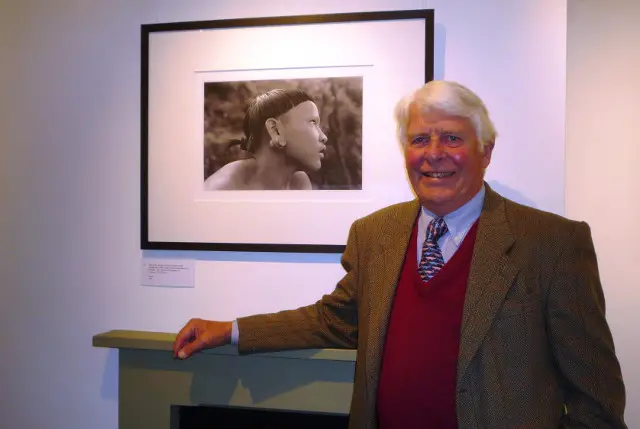One of the greatest explorers this country has produced spent last Saturday at Dimbola Museum and Galleries helping to set up an exhibition of his photographs and selected artefacts.
Robin Hanbury-Tenison OBE undertook his first expedition in the late 1950s and continued into the 1970s.
Prodigious photographer and collector
On his travels he was a prodigious photographer and collector of artefacts as he witnessed the erosion of tribal people’s homelands.
As a tireless champion of the rights of tribal people Robin was the founder and is now the president of the charity ‘Survival International’.
‘Echoes of a Vanished World’
On Saturday evening Robin was on hand to personally open ‘Echoes of a Vanished World’. What is on view at Dimbola until the 5th January 2014 is a scaled down version, because of the space available, of what was on display at the National Theatre in London recently.
Introduced by Dr Brian Hinton MBE Robin said he was completely bowled over and humbled to be there walking in the footsteps of Julia Margaret Cameron. Insisting he was not a photographer (“I am an explorer”) he said he was interested to learn a certain poet “who did not know how to spell his name properly” lived nearby.
Collection moves to National History Museum at Eton College
Robin went on to say he was anxious that his personal collection of photographs and artefacts should be kept intact. Fortunately a benefactor came forward to give a generous donation to his favourite charity.
In the New Year his complete collection will be housed at the National History Museum at Eton College.
What you can see at Dimbola
Artefacts on display at Dimbola include a Tuareg sandal from the Air Mountains in the Sahara and is described as the original Flip-flop!
Kalahari bushmen are responsible for a bracelet and necklace fashioned from an Ostrich egg and intricate weaving is shown on several items.
One photograph highlights the deforestation of the Brazilian Amazon with the arrival of cattle ranchers, 50% of the land has now been cleared.
On the Tinjar River in Sarawak girls used heavy brass weights to stretch their earlobes down to their shoulders. In Borneo the Penan are highly skilled with blowpipes. Xavante Indians in Brazil prefer using bows and arrows.
Rich gardens of sweet potatoes, hidden in the Western Highlands of remote Baliem Valley, are farmed by the Dani in the Indonesian part of New Guinea. Blue People of the Sahara are so called because their veils are dyed with indigo and made from Sudanese cotton.
Each photograph tells its own story and shows the ever vanishing World in an exhibition arranged by Rachel Flynn and sponsored by publishers Thames and Hudson.
It runs 5th January 2014 and Robin will be giving a talk at Dimbola in October.





